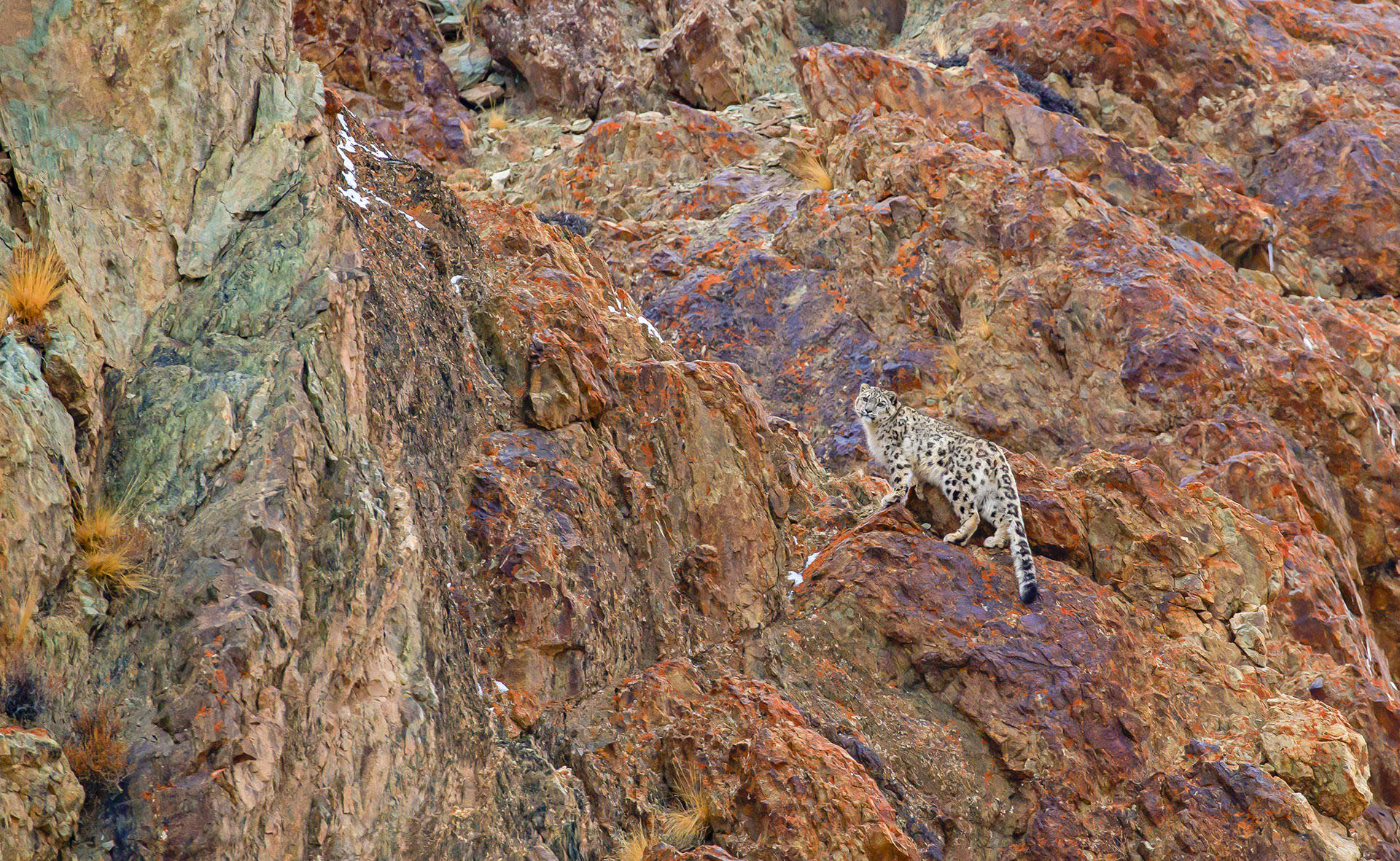 Listen to this article
•
15:34 min
Listen to this article
•
15:34 min
2001, Malleshwaram, Bangalore
It was that hour. When the passing of day and the coming of night was marked by the burning of incense, the lighting of a little oil lamp, and the earnest offering of prayers. My father, in his white lungi, having just bathed, would close his eyes and whisper to the deities as he turned on the lights every evening. In the hour that God was invoked, I saw the snow leopard for the very first time.
She was there, an adult female, looking back at me from the convex screen of our cable television set, about to turn my world upside down and sideways when the day came. I saw her whiskers twitch as she sniffed the cold night-air; I saw her pale coat and her glassy, ashen irises. Then, as she descended a rocky ridge toward the village, I saw her thick and furry tail slither mid-air like a king cobra. ‘Although she is in the open, only a few metres away…nobody sees the ghost cat coming,’ interrupted the raspy voice of the narrator. In this moment, something in me stirred; a feeling I didn’t know I could feel. I was just a schoolboy then. Perhaps too young, too raw to receive that feeling for what it was. Maybe I would one day understand.
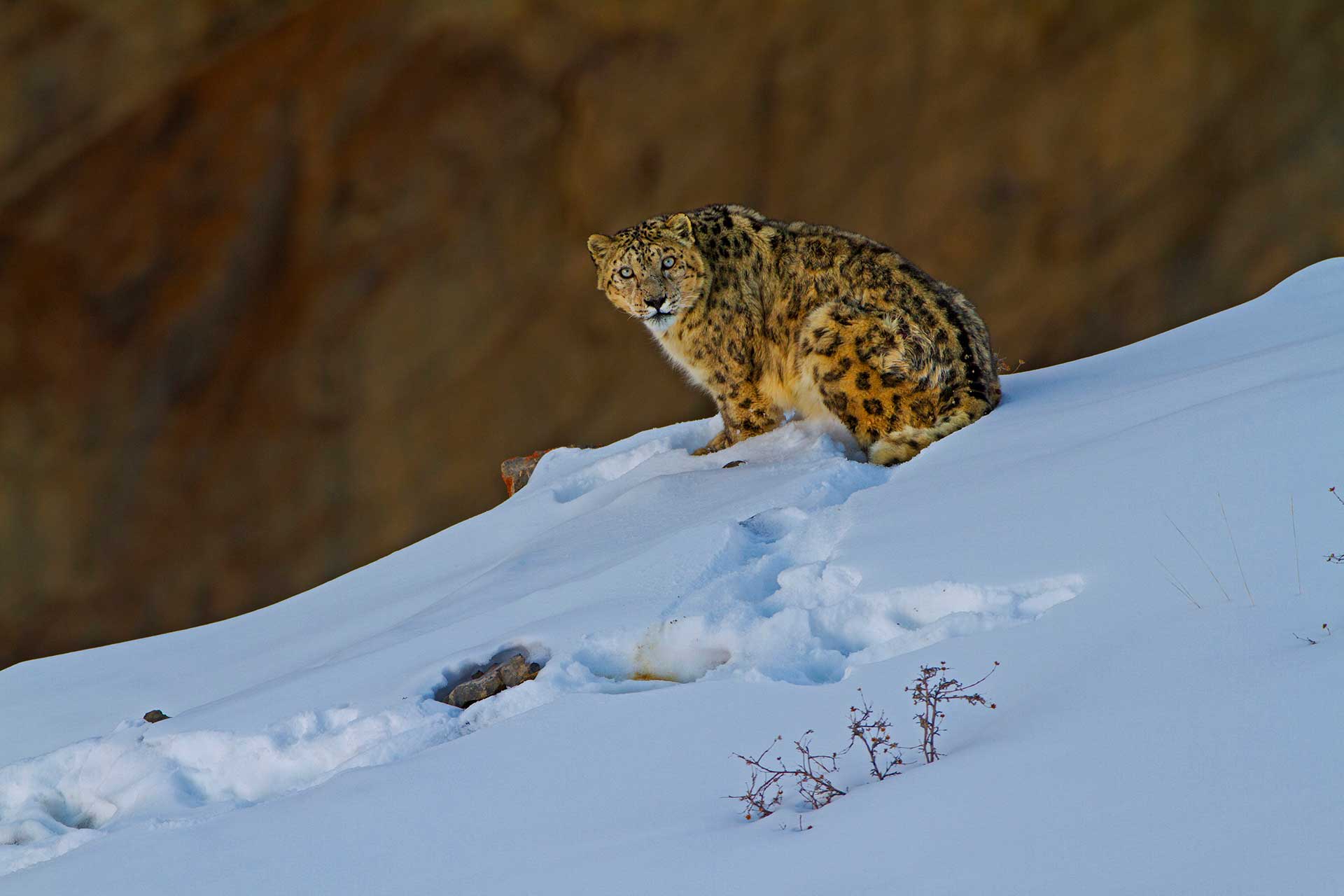
The snow leopard's underfur reaches a thickness of around 12 cm, affording it protection against the extreme cold in its harsh mountain habitat. Photo: Dhritiman Mukherjee
Cover photo: The snow leopard's ability to blend with it's surroundings and to disappear at will earns it the title 'Grey Ghost of the Mountains' or 'Ghost Cat'. Photo: Dhritiman Mukherjee
2012, Gangtok
With an entire day to spare after finishing a work project in rural Sikkim, I found myself ambling along the mountain paths of Gangtok with friends. We came across a proud board that announced that beyond it lived the clouded leopard and the red panda, in almost natural enclosures. Having promised myself I would never set foot in a zoo or anything like one, I readily broke my resolve and entered. Knowing that only a few metres from me were beautiful beasts like the clouded leopard, red panda, and the Tibetan wolves, I acted viscerally. It was a guilt-free experience — being overwhelmed by the eyes of a clouded leopard staring back at me from behind its cage, watching a shy Tibetan wolf poke its wet nose out from its man-made den, gaping at raptors who were introduced as ‘Raiders of the Sky’ as they hopped from one branch to another in their enclosure, all of 30 feet tall. I didn’t stop to think until I stood where the road forked and one board pointed right indicated ‘Himalayan Brown Bear’ and another board pointing left proclaimed ‘Snow leopard (Panthera-Uncia)’.
From the first time I saw the snow leopard on the television a decade before, I had casually read about the creature from time to time in curious fits and starts. It was always a distant vision to see one with my own eyes. I had read about how elusive they were. How men and women had spent years trying to lay their eyes on one, and that they had come to be known as the ‘Grey Ghost of the Mountains’. I had even imagined myself seeing it for the very first time. ‘At some point in my life’, I had said to myself.
Now, less than a minute from where I stood was ‘Malaika’ a snow leopard captured from Arunachal Pradesh. One part of me revolted. Then at once, all of me. ‘Not here, not like this…’. With a thought or two for Malaika, I turned around and left, to wait for my friends at the gate.

2013, Snow Leopard Conservancy India Trust, Leh
Waiting outside a veiled door, I recalled the events of the past 14 months. After being physically so close to a snow leopard, a desperate urge to sight one in the wild had taken over my thoughts. After returning to Sikkim, I wrote to the Snow Leopard Conservancy India Trust (SLCIT) in Leh enquiring about volunteering opportunities. I was called in to help with their social media platforms. Behind the door were two men. Tsewang Namgail, the Director of SLCIT, is an accomplished man known for his remarkable knowledge of migratory birds in the Himalayan region. He was the first person to report the occurrence of the Tibetan sand fox in India. Tsewang has travelled the world as much as he has traversed the unreachable corners of his homeland. He had stories to tell. With him, was Jigmet Dadul, a qualified librarian who has come to be regarded as the most skilled snow leopard spotter in the world, besides being an immeasurably compassionate conservationist. He carried with him a little diary in which he would note all of his sightings to date. I counted over 250 accounts scribbled dutifully against the dates in the diary. I imagined a diary of my own.
After a quick briefing, I was at once taken aboard this beautiful work-machine trundling along the farthest corners of Ladakh; a handful of passionate people who give the best of themselves every day. I assisted them in workshops that educated teachers in Kargil about the importance of ecological balance.
I travelled to Rangdum where they trained locals to convert their homes into homestays for income opportunities. In Nubra I witnessed them teaching the women to needle-felt their wool into adorable little dolls for sale. In Saspochey they trained youth to be nature guides.
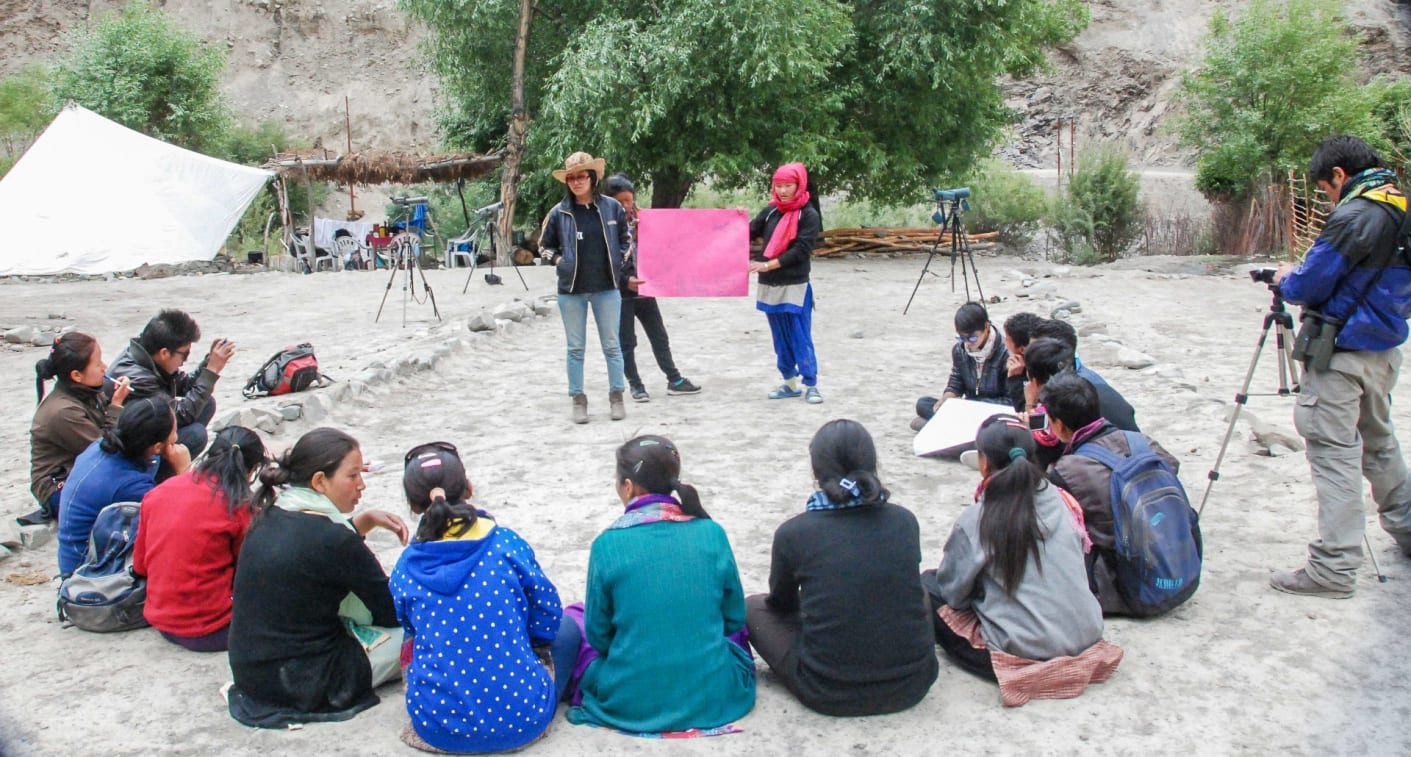
The Snow Leopard Conservancy India Trust staff conduct nature guide trainings for locals in Ladakh’s Sham Valley. Photo: Pankaj Singh
In Phugtal they educated monks and nuns, who in turn would educate the locals about the environment. In Tuk-la, I watched them erect a roof above the livestock corals of shepherds so that snow leopards wouldn’t get in. In Saspol they set up electric fences to prevent crop damage from grazing urials (wild sheep). For the ones who lost their cattle to snow leopard attacks, they offered insurance. Two months passed unnoticed. I was left overwhelmed with the work they so passionately carried out. They were doing all of this, just so that the apex predator of the region, and all the creatures that thrived in her gaze, had a safe and abundant habitat to exist in. I was fascinated how the snow leopard, unseen and untraceable, far away from everybody else, had stirred into being this fantastic universe just by existing.
I left Ladakh that year slightly dejected about not having seen a snow leopard. More importantly, I was grateful to have been exposed to the various intricacies of ecology and coexistence between man and beast in Ladakh. I saw how everything was connected. Every little activity I participated in with the SLCIT made be believe I was in some small manner preserving the world this fantastic beast exists in…and that was enough.
I returned many times over the following years in various capacities: to help build solar-powered electronic gadgets; pursue a photo-story; for visual documentation etc. I sometimes spent months working with the SLCIT. I came across people who had spotted their first snow leopard on their first visit. I wondered why I wasn’t as lucky.
I realised this was because I really hadn’t gone looking. Unlike many people who went into the mountains for days with the sole intention of sighting a snow leopard. My ‘searching’ had been limited to drives with Jigmet in his immensely rickety Gypsy, when he would stop for a break and scan the ridges for a few minutes. Nearly all of my time in Ladakh had been spent in partaking in the activities of the organisation. By the fourth year, I didn’t want it so much. I carried on working and told myself it was okay not to have seen one yet. By now, I didn’t want to go looking for a snow leopard. I wanted to come across one. ‘It is not about how much you look, it is about when the Shan decides to show herself,’ Jigmet had told me. So I waited, patiently. Leaving the one thing I wanted so dearly to chance felt oddly comforting.
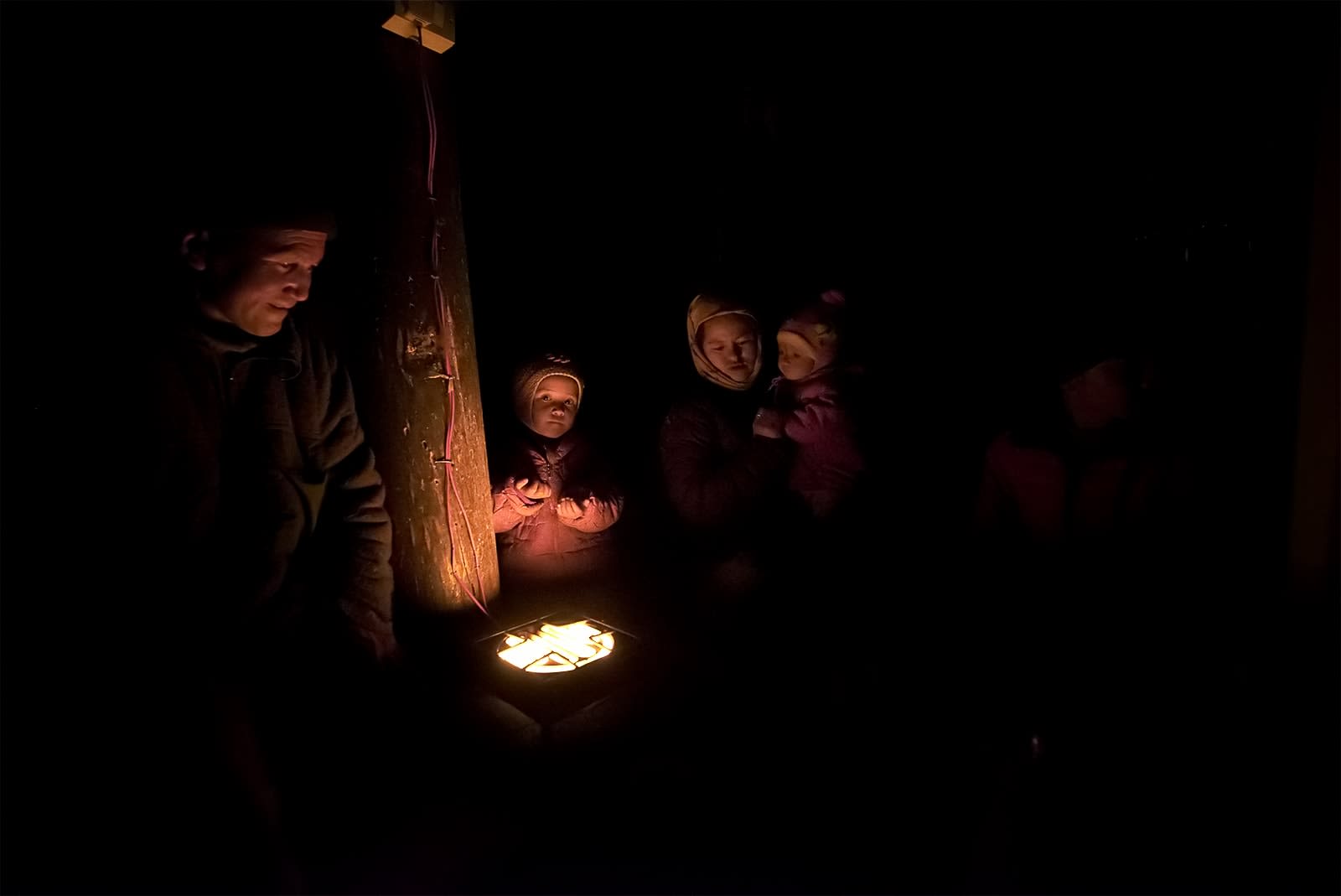
Temperatures may drop well below -30 degrees Celsius in Ulley. Family members gather around an electric heater for warmth. Photo: Pankaj Singh
2017, Ulley, Ladakh
Before Ulley became the Mecca for snow leopard sightings in Ladakh, it was a quieter place. There are seven families that live there. That cold January of 2017, I was in the last house in the village. The one that sat alone on a hill. With me were friends and some of the colleagues of SLCIT. We were there to make a film about the family that lived there and their association with the SLCIT. How despite being distant from everything else, they were being educated, trained in the arts, and made aware of the outside world as well as their own land.
We were filming a sequence on the roof where the family members were asked to pretend to be observing wild animals through the spotting scopes. I was taking a break from the cold in the winter kitchen, drawing in all the warmth I could, beside the rumbling rocket stove. The chimney from this stove ran up through the ceiling and I could hear muffled voices from the roof, coming down the hot pipes below. Our instruments had stopped recording temperatures at -20 degrees Celsius so I cannot be sure how much colder it was. In my mind was the vision of my mother pouring a cup of frothing hot filter coffee far away in Bengaluru, in that very moment. The voices in the pipes had ceased. Behind the door, I heard my name. ‘Snow leopard! Come!’
I ran. Slipping on shoes was cumbersome with gloves on. So I ran up in my inefficient general store socks. Gyaltson, Jigmet’s son, while pretending to point the family toward wildlife for a shot in the film, had actually sighted a snow leopard up on the peak. A complete fluke.
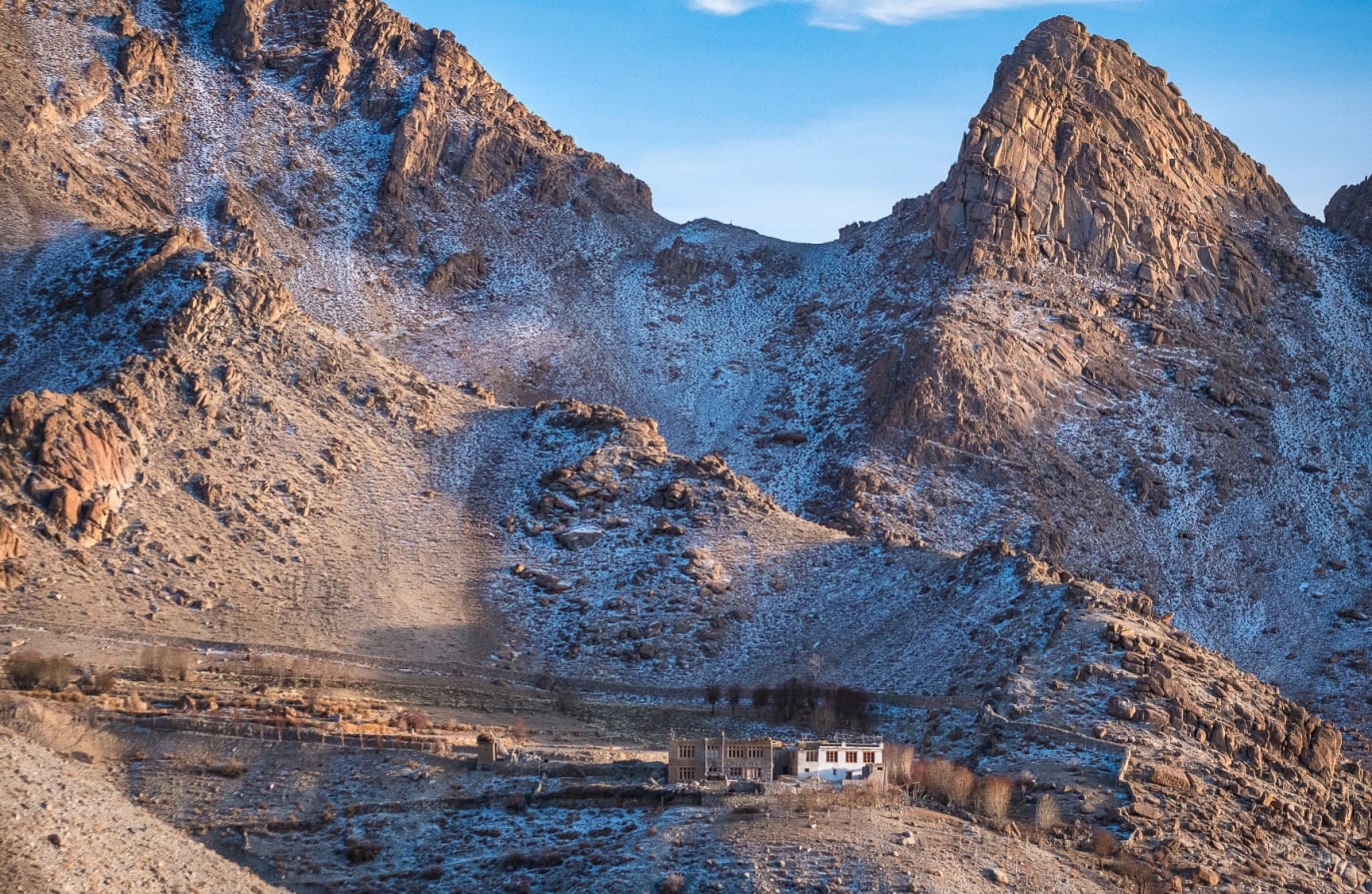
Owing to tourism focused on the snow leopard, the local economy of villages such as Ulley in Ladakh has seen an upturn in recent years. Photo: Yogesh Pilankar/Shutterstock
One of them made way for me to look. I slowly pressed one eye against the cold glass of the Swarovski scope. I heard jubilation and hugs being exchanged behind me. She was there, sitting idly. About a 1,000 feet above, nearly a kilometre away. A dusty dot looking into the sun, unaware of my throbbing heart far below.
It wasn’t that she was always there. It wasn’t that I was always looking. But she was here, now…and so was I. She had shown herself and I had simply come across her.
I watched her for a few seconds before making way for others. A minute later I looked again, she stood up, stretched herself and disappeared behind the ridge. Her long, furry tail trailing mid-air like a king cobra. I had spent 11 years being fascinated and another 5 years being physically close to her in over 13 visits, and I had seen her for all of 25 seconds. I could not have asked for more.
For years, I had pictured this moment — imagined how I would feel when I saw the ghost cat for the first time. The things I would say, and the words I would use, the sentences I would string together like beads on a line to describe what I felt. When I play back that memory, I draw an absolute blank. I knew I felt something that day. Something deep, something true and precious. A feeling I didn’t know I could feel. I am at once the schoolboy I was then, sitting before the old cable television, believing he would one day understand.



